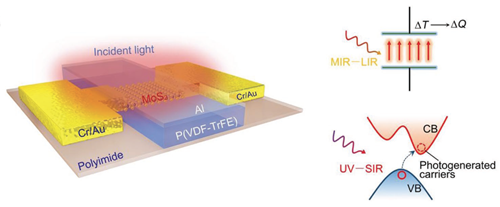- 首页 >> Research >> Research Progress
Research Progress
Shanghai Institute of Technical Physics has made important progress in the research of ultrabroad spectrum detectors
Recently, Prof. Jianlu Wang and Prof. Weida Hu et al, from State Key Laboratory of Infrared Physics, Shanghai Institute of Technical Physics, Chinese Academy of Sciences, have made important progress in ultrabroad spectrum detection by combining pyroelectric materials with a low-dimensional semiconductor. Multi-mechanism coupling in these two-type materials was used to realize the detection wavelength from the ultraviolet-visible-short to mid-wave and then to the long-wave infrared spectrum. The results were published in the journal “Advanced Science” (Adv. Sci., 2019, 6: 1970089) with the topic “Multimechanism Synergistic Photodetectors with Ultrabroad Spectrum Response from 375 nm to 10 μm”. The impact factor of “Advanced Science” is 15.804 and this paper was selected as the cover article.

The paper was selected as the cover article of “Advanced Science” .
Infrared detection technology has important applications in various fields such as the military and people's livelihood. With the increasing demand for applications, infrared detection technology is developing towards ultra-sensitive, high-resolution, wide-spectrum. Among them, expanding the response spectrum range and improving sensitivity is of great significance for dealing with intelligent information acquisition in complex environments. Infrared detectors can be divided into two categories according to the detection principle. One is based on the thermal effect of infrared radiation, the detector that uses temperature sensitive to infrared radiation is called “thermal sensitive detector”; the other is the use of photoelectric effect, the principle is that electrons in material directly absorbs infrared radiation and changes in transport state, such detectors based on infrared radiation changes the electrical properties, called “photodetector” or “photon detector”.

The pyroelectric detectors detect infrared radiation by monitoring the surface charge of a sensitive element as a function of temperature due to infrared radiation. These detectors cover a wide range of radiation wavelengths, operate at room temperature, are small, lightweight, and inexpensive. The main factors that restrict the performance of pyroelectric detectors are the high-efficiency thermal isolation, the noise introduced by the amplified readout circuit, the time constant and so on. Low-dimensional semiconductors have attracted extensive attention and rapid development due to their unique low-dimensional structure and excellent optoelectronic properties. They have advantages of small size, low power consumption, and high sensitivity when used for photodetectors. However, due to the low absorption efficiency, low-dimensional semiconductors are greatly limited in the field of infrared detection.
The researchers combined ferroelectric materials with low-dimensional semiconductors to prepare the field-effect transistor. The device was fabricated on an ultra-thin polyimide substrate (thickness of only 1.7 μm) to improve thermal isolation. In this transistor, the low-dimensional semiconductor molybdenum disulfide (MoS2) is the channel material, and the organic ferroelectric polymer polyvinylidene fluoride (P(VDF-TrFE)) is the gate dielectric. Through the multi-mechanism coupling of ferroelectric materials and low-dimensional semiconductors, the response spectrum of the detector can continuously cover the ultraviolet to long-wave infrared (375 nm-10 μm). Among them, in the mid-wave to the long-wave infrared band, the photoresponse of the device is mainly due to the pyroelectric effect of the ferroelectric material, while the low-dimensional semiconductor is used to read and amplify the pyroelectric current caused by the infrared radiation, the device structure, and the principle is shown in Figure 1. Therefore, the sensitivity of the device in this band is greatly improved by the combination of the pyroelectric effect of the ferroelectric material and the semiconducting characteristic and interface characteristic of the low-dimensional material. In the ultraviolet to the near-infrared range, the device performance has been further enhanced by improving the structure and fabrication process of the device, which is a continues research work of our group (Advanced Materials, 2015, 27, 6575). In this work, we successfully obtained single-pixel imaging of visible light targets. In summary, this work combines the pyroelectric effect and polarization characteristics of ferroelectric materials, and semiconducting characteristics, photoconductivity, field-effect of low-dimensional semiconductors, through a variety of physical mechanisms to achieve synergy, thus achieving high-performance ultrabroad spectrum response detector. The process involved in this work is simple and stable, laying the foundation for the development of large-area flexible room temperature wide-spectrum focal plane devices.
The work was supported by the National Natural Science Foundation of China, the Ministry of Science and Technology, the Chinese Academy of Sciences and the Shanghai Municipal Science and Technology Commission.
Article link:https://doi.org/10.1002/advs.201970089